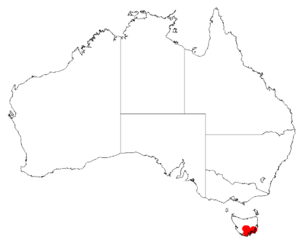Derwent cascade facts for kids
Quick facts for kids Derwent cascade |
|
|---|---|
| Scientific classification | |
| Genus: |
Acacia
|
| Species: |
derwentiana
|
 |
|
| Occurrence data from AVH | |
Acacia derwentiana, also known as Derwent cascade, is a type of shrub. It belongs to the large group of plants called Acacia, often known as wattles. This plant is special because it only grows naturally in Tasmania, an island state of Australia.
Contents
What Does Derwent Cascade Look Like?
This shrub usually grows between 1 and 3 meters tall. Sometimes, it can even reach up to 5 meters high. It has thin branches that often droop or hang down at their ends.
Leaves and Flowers
Like most Acacia plants, the Derwent cascade does not have true leaves. Instead, it has what are called phyllodes. These are flattened leaf stems that act like leaves.
The phyllodes are flat and stay green all year. They are long and narrow, measuring about 2 to 6.5 centimeters in length. They are only 1 to 2.5 millimeters wide. These phyllodes have a sharp point and three main veins. The middle vein is the easiest to see.
When the plant blooms, it produces simple flower clusters called inflorescences. These look like small, cylindrical spikes. The flower spikes are about 1 to 2.5 centimeters long. They are filled with pale yellow to light lemon-yellow flowers.
Seed Pods
After the flowers bloom, seed pods begin to form. These pods are long and can be straight or slightly curved. They are often pinched in between each seed. The pods are about 2.5 to 5 centimeters long and 2 to 4 millimeters wide. Inside, they hold oval-shaped seeds.
How is Derwent Cascade Related to Other Plants?
Acacia derwentiana is very similar to another plant called Acacia riceana. However, the Derwent cascade has longer phyllodes, which helps tell them apart.
Where Does Derwent Cascade Grow?
This plant is found only in the southern parts of Tasmania. This means it is endemic to that area. You can mostly find it growing along the banks of the Derwent River. It also grows along some smaller rivers that flow into the Derwent, like the Broad and Tyenna Rivers. You might also see it near the Carlton River and Prosser Rivers. It grows in areas to the north and east of Hobart.

